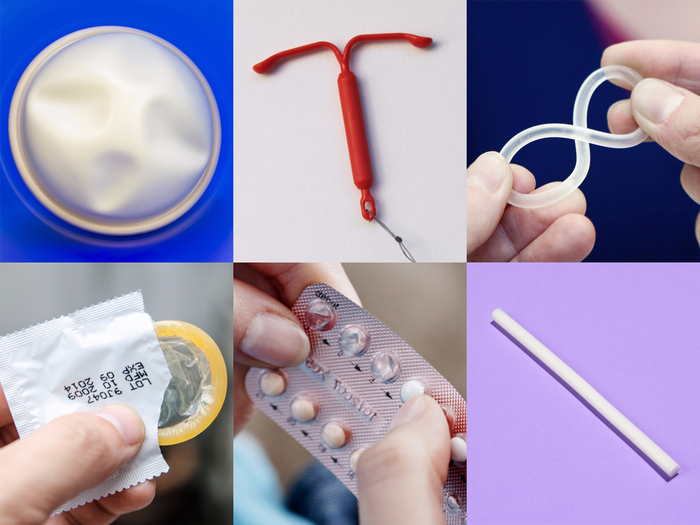Birth control is any activity, medicine, or equipment used to prevent pregnancy. There are many types of birth control available for women who do not wish to become pregnant. The decision on which method is right for you should be made with your healthcare provider, as well as with your partner.
Birth control methods work in different ways to prevent pregnancy, including:
- Creating a barrier that blocks sperm from reaching the egg
- Killing sperm
- Preventing eggs from being released by the ovaries
- Changing the cervical mucus to hinder sperm from moving into the uterus
- Altering the tissue lining the uterus so that a fertilized egg can’t implant

What are the different types of birth control?
Some methods that don’t require a prescription from your healthcare provider include:
- Abstinence. Not having sex.
- Spermicides. Foams or creams placed inside the vagina to kill sperm. These may also provide some protection against sexually transmitted infections. This is especially possible when used with a latex condom.
- Male condom. A thin tube made of latex or a natural material that is placed over the penis. The sperm is collected in the end of the condom. Latex condoms may provide some protection against sexually transmitted infections.
- Female condom. A liner made of latex or natural material that is placed inside the vagina. Latex condoms may provide some protection against sexually transmitted infections.
- Natural family planning. Timing sex to avoid fertile days using various methods of monitoring body temperature. It also involves watching for changes in cervical mucus, and the use of ovulation prediction kits. This method, often known as the rhythm method, has a high risk for pregnancy.
Some methods that require a visit to your healthcare provider for an exam and a prescription include:
- Oral contraceptives (birth control pills). Medicines taken daily that prevent ovulation by controlling pituitary hormone secretion. Usually, oral contraceptives contain the hormones estrogen and progestin. In addition to prevention of pregnancy, oral contraceptives have several health benefits including regulating menstrual cycles and decreasing the amount and length of menstrual periods. This can help increase iron stores in women with iron deficiency associated with excessive bleeding. Prevention of certain ovarian and endometrial cancers is a significant benefit of the use of oral contraceptives. Some research has found that some benign (noncancerous) breast diseases happen less often with the use of oral contraceptives. These breast diseases include fibroadenoma and cystic changes. Recent studies have also suggested that oral contraceptive use may reduce the occurrence of severe disabling rheumatoid arthritis.
- Mini-pill. Unlike the traditional birth control pill, the mini-pill has only the hormone, progestin. Taken daily, the mini-pill thickens cervical mucus and prevents the sperm from reaching the egg. The mini-pill also can decrease the flow of your period and protect against pelvic inflammatory disease and ovarian and endometrial cancer.
- Implant. A capsule containing the synthetic hormone etonogestrel is implanted under the skin in the upper arm of a woman. This continuously prevents the ovaries from releasing an egg for up to 3 years. A local anesthetic is needed for insertion and removal of this type of birth control.
- Injection. A progesterone-like drug given by injection to prevent pregnancy by stopping ovulation. The effects last for about 3 months and another injection must be given to continue birth control effectiveness.
- Patch. This is a skin patch worn on the body that releases the hormones estrogen and progestin into the bloodstream. It is most effective in women who weigh less than 198 pounds.
- Diaphragm or cervical cap. A dome-shaped rubber cup with a flexible rim that is inserted through the vagina to cover the cervix. This type of birth control must be inserted before having sex.
- Hormonal vaginal contraceptive ring. A ring that is placed inside the vagina around the cervix. The ring releases the hormones estrogen and progestin.
- Intrauterine device (IUD). Devices placed in the uterus through the cervix by a healthcare provider. The IUD works by thickening cervical mucus to make it hard for sperm to enter the cervix. Or by preventing the fertilized egg from attaching to the wall of the uterus. IUDs containing hormones are also called intrauterine systems and must be replaced every 5 years, while copper IUDs can last up to 10 years.
Surgery that results in the inability to become pregnant includes:
- Hysterectomy. Removal of the uterus and usually the ovaries and Fallopian tube. This is a permanent form of birth control.
- Tubal ligation or tubal occlusion (“tying the tubes”). Surgery to cut, cauterize, or band the Fallopian tubes to prevent the egg from being transported to the uterus. Tubal ligation is designed to be a permanent method of birth control. Although certain types of tubal ligation can be reversed, the reversal procedure may not be successful.
- Tubal sterilization Essure system. This permanent form of birth control can be done as an outpatient procedure without a surgical incision. During the procedure, a thin tube is used to thread a tiny, springlike device through the vagina to the uterus into each Fallopian tube. A material in the device causes scar tissue to develop and permanently plug the tubes after about 3 months. Other forms of birth control must be used during that time. An X-ray or ultrasound must be done to confirm that the tubes are blocked
- Vasectomy. Cutting or clamping the vas deferens (sperm duct). These are the tubes that carry the sperm from the testes. The testes still produce sperm, but the sperm die and are absorbed by the body. This is a permanent male birth control measure.
The following are not reliable methods of birth control:
- Withdrawal before ejaculation
- Sex during menstruation
- Standing up immediately after sex
- Douching after sex

